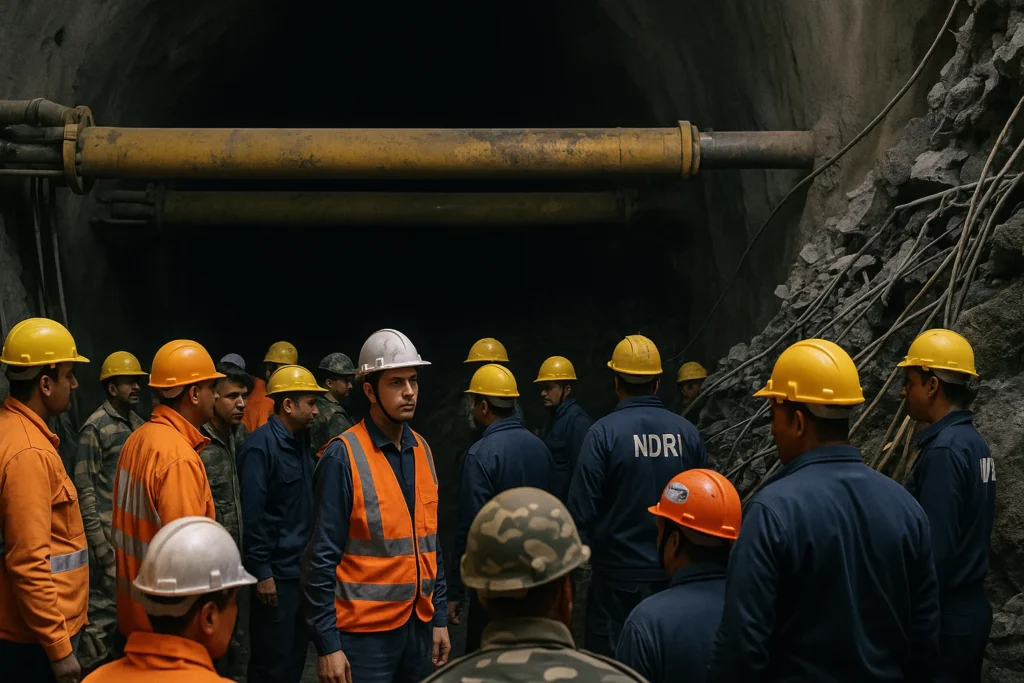Introduction: Diwali in Darkness
On November 12, 2023, as much of India lit up in celebration of Diwali, a dark shadow fell over the remote district of Uttarkashi in Uttarakhand. A section of an under-construction tunnel on the Char Dham all-weather highway project collapsed. Forty-one workers—sons, fathers, husbands—were trapped inside, sealed behind layers of debris, concrete, and uncertainty. What followed was a race against time: 17 days of digging, drilling, and desperation. While homes across the country glowed with lights and laughter, these men sat in darkness, breathing the dusty air of survival.
The Collapse: How It Happened
The Silkyara-Barkot tunnel was part of India’s ambitious Char Dham highway project, which aimed to improve connectivity to sacred pilgrimage sites. While hailed as an engineering feat, geologists and environmentalists had raised concerns for years. The tunnel passed through fragile Himalayan terrain, prone to landslides and seismic activity.
On that fateful day, a portion of the tunnel collapsed due to a combination of weak geological strata and construction pressure. A sudden crash, a tremor, and then silence—41 workers found themselves sealed in a dark corridor of rock and uncertainty. The debris trapped them about 200 meters from the entrance, cutting off all escape.
Day One to Day Seventeen: A Multinational Rescue Mission
The rescue was anything but straightforward. The first hours were marked by chaos and communication challenges. Authorities quickly moved to mobilize forces: the National Disaster Response Force (NDRF), Indian Army engineers, local administration, and even international tunnel experts. Rescue teams from Thailand, Norway, and Austria were flown in to advise and assist.
Over 200 people worked in shifts, using everything from drilling machines to robotic cameras. Initial attempts with heavy machinery triggered additional cave-ins. There were moments when rescuers had to halt all activity due to safety concerns. Boreholes were drilled to insert oxygen pipes, food tubes, and fiber-optic cables for communication.
Despite the setbacks, innovation prevailed. A 900mm steel pipe was manually pushed through the debris—a feat that took more than 72 hours. This pipe, wide enough for a person to crawl through, became the escape tunnel. One by one, workers were pulled out using stretchers mounted on wheeled sleds.
All 41 survived.
Who Were the Trapped Workers?
They were laborers from across India—Bihar, Jharkhand, Odisha, Uttar Pradesh. Many of them were young fathers, newlyweds, or sons supporting aging parents. For these workers, the tunnel job was an opportunity to earn and save. For some, it was their first construction assignment outside their home state.
Survivors recalled singing folk songs to keep their morale up. Others marked days by scratching walls. One laborer said he imagined himself outside, walking in the hills again. The rescue became not just a technical marvel but a deeply emotional moment for families who had spent sleepless nights camped at the tunnel entrance.
The Shadow of Joshimath and a Pattern of Risk
This was not the first ecological red flag in Uttarakhand. Just months earlier, the town of Joshimath was declared a sinking zone. Cracks in homes, roads, and buildings forced over a thousand evacuations. The images of splitting houses and panicked families were still fresh in public memory.
Both Joshimath and the tunnel collapse point to a troubling pattern: unchecked construction in one of the world’s youngest and most fragile mountain ranges. Seismologists have long warned that the Himalayas, still rising due to tectonic movements, are extremely sensitive to anthropogenic changes.
Char Dham Project: Devotion vs. Destruction?
Launched in 2016, the Char Dham highway project was designed to connect Yamunotri, Gangotri, Kedarnath, and Badrinath through a network of all-weather roads. The idea was to provide pilgrims easier access, even during harsh weather.
However, many experts have voiced concerns:
- Thousands of trees have been cut down.
- Slopes have been destabilized.
- Landslide incidents have increased in project zones.
While spiritual tourism and national security are valid goals, the cost seems to be mounting in lives and landscapes. Roads have become both symbols of progress and precursors of disaster.
Tunnel Construction in the Himalayas: High-Risk Engineering
Building tunnels in the Himalayas is not like anywhere else. The region is seismically active, has unpredictable geology, and is vulnerable to climate change. Despite these known risks, tunnel construction continues, often with limited data, outdated techniques, and enormous pressure to meet deadlines.
Questions now echo louder:
- Were proper geological surveys conducted before excavation?
- Did environmental clearance processes include community consultation?
- Who audits these mega-infrastructure projects?
In this case, there are allegations that poor-quality rock support, insufficient data modeling, and hurried deadlines may have contributed to the collapse.
Government Response and Political Backlash
The rescue was praised nationally, even internationally. However, criticism poured in regarding:
- Delayed action in the initial hours
- Lack of disaster preparedness
- Prior warnings by environmentalists being ignored
Opposition parties accused the government of pushing development without adequate safety checks. The state government ordered an inquiry, but past inquiries into similar incidents have yielded little.
Meanwhile, the Centre emphasized the rescue as a “victory of coordination and commitment.” But locals in Uttarkashi whispered a different truth: had caution been taken, there would have been no need for a miracle.
The Human Cost: Physical and Emotional Toll
The men trapped inside faced extreme psychological stress. The air was thin, the light minimal. Sanitation was makeshift. Rescuers pushed in water, dry fruits, and glucose, but hunger gnawed at their morale. Medical experts now worry about long-term effects on their lungs, eyesight, and mental health.
For families, it was trauma. Children missed school to wait outside the tunnel. Some elderly parents developed health issues from stress. Even after rescue, the road to recovery—mental and physical—remains long.
The Broader Message: Natural vs. Man-Made Disasters
This tragedy is a mirror held up to India’s Himalayan development strategy. As climate change increases the frequency of landslides and flash floods, how wise is it to continue aggressive infrastructure expansion in ecologically fragile zones?
Where do we draw the line between human ambition and ecological wisdom? Can modern infrastructure respect ancient landscapes?
Learning the Right Lessons: The Way Ahead
The Uttarkashi disaster offers many lessons:
- Mandatory geological risk assessments must precede any project.
- Disaster drills and rescue plans should be part of every site operation.
- Worker rights and safety measures must be enforced.
- Public accountability and environmental transparency should be non-negotiable.
The hills may be silent, but they speak in cracks and collapses. It’s time to listen.
International Attention and Future Implications
The Uttarkashi incident has also sparked interest internationally. Global tunnel safety experts are now reviewing India’s mountain engineering practices. Infrastructure investors are calling for revised safety protocols. For Himalayan nations like Nepal and Bhutan, the tragedy is a warning too.
As India embarks on the next decade of infrastructure expansion, it must lead by example—not just in execution but in ethics.
A Nation Reflects
While the rescue was heroic, the fact that it was needed at all is a somber reminder of the costs of negligence. Development is important, but so is life. As India builds its future, it must ensure that its foundations—both literal and figurative—are stable.
Share Your Thoughts
Have you been affected by or witnessed infrastructure development in sensitive regions? What do you think should be prioritized—speed or safety, progress or preservation? Share your stories, thoughts, and questions in the comments below.




Hey there!
Welcome to Moviezhive.com, where blockbuster entertainment is just a click away!
Stream a vast collection of Bollywood, Hollywood, and international movies for free—no subscriptions, no hassles.
What Makes Us Special?
✔️ Thousands of movies across all genres
✔️ Zero pop-up ads for seamless viewing
✔️ Advanced zero-buffering tech for smooth playback
✔️ Fresh titles added regularly
Can’t find a movie? Request it, and we’ll upload it fast!
Watch anytime, anywhere. Visit https://moviezhive.com now and start your movie adventure!
Enjoy the Show,
The Moviezhive Team
Если требуется качественный результат, можно прогон хрумером заказать https://www.olx.ua/d/uk/obyavlenie/progon-hrumerom-dr-50-po-ahrefs-uvelichu-reyting-domena-IDXnHrG.html у специалистов.